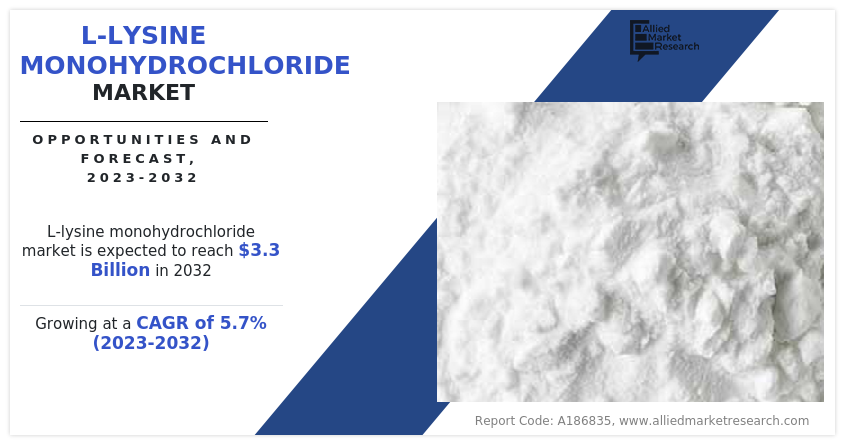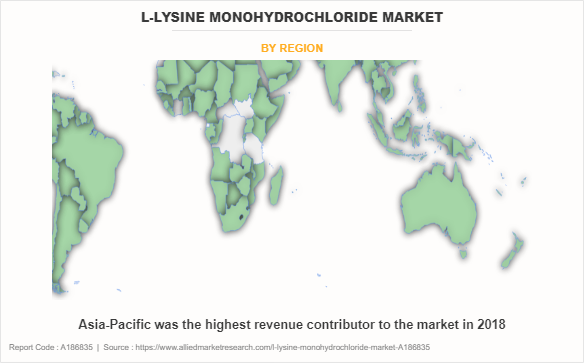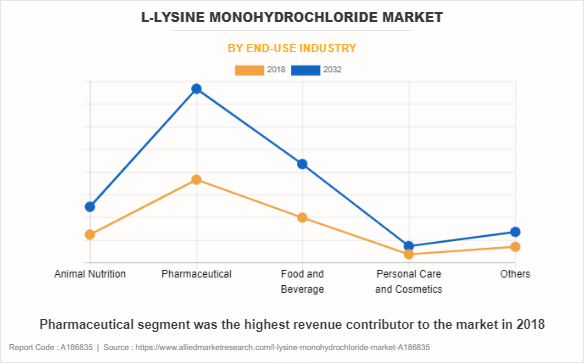L-Lysine Monohydrochloride Market Research, 2032
The global L-lysine monohydrochloride market size was valued at $1.6 billion in 2018, and is projected to reach $3.3 billion by 2032, growing at a CAGR of 5.7% from 2023 to 2032.
Report Key Highlighters:
- More than 6,765 product literatures, industry releases, annual reports, and other such documents of major industry participants along with authentic industry journals, trade associations' releases, and government websites have been reviewed for generating high-value industry insights.
- The study covers more than 20 countries. The segment analysis of each country in terms of value and volume during the forecast period 2018-2032 is covered in the L-Lysine monohydrochloride market report.
- The key players analyzed in the report are Alpspure Lifesciences Pvt. Ltd., Foodchem International Corporation, Sisco Research Laboratories Pvt. Ltd., RX Chemicals, Loba Chemie Pvt. Ltd., JIGCHEM UNIVERSAL, Haihang Industry, Toronto Research Chemicals Inc., Central Drug House, Tokyo Chemical Industry Co., Ltd.

L-Lysine monohydrochloride, commonly known as lysine HCl, is a form of the essential amino acid lysine. It is used as a feed additive to optimize the protein content and amino acid profile of animal diets. It enhances the efficiency with which animals convert feed into muscle mass, leading to improved growth rates and feed conversion ratios.
Growth in the animal feed industry is expected to drive the L-lysine monohydrochloride market growth during the forecast period.
There is an increase in the demand for animal-derived protein sources such as meat, milk, and eggs with rise in global population. This demand drives the expansion of livestock production, which includes poultry (chickens, turkeys), swine (pigs), and ruminants (cattle, sheep, goats). L-lysine monohydrochloride is added to animal feed to ensure optimal protein intake for these animals, which is crucial for their growth and development. Besides, with declining wild fish stocks, the aquaculture industry has expanded to meet the demand for seafood. Farmed fish, shrimp, and other aquatic species also require balanced nutrition for growth and health. L-lysine monohydrochloride serves as a valuable component in aquaculture feeds to ensure that fish and other aquatic animals receive the essential amino acids they need.
Moreover, L-lysine monohydrochloride is considered a limiting amino acid in many animal diets, meaning that the availability of this amino acid can restrict the animal's ability to utilize other amino acids present in the feed. By supplementing animal feed with L-lysine monohydrochloride, the overall protein utilization and efficiency of feed conversion can be improved. This leads to better growth rates, reduced feed costs, and improved profitability for livestock producers.
However, the price volatility of raw materials is expected to act as a major restraint for market growth. The production of L-lysine monohydrochloride involves the fermentation of raw materials such as corn or sugarcane. Fluctuations in the prices of these raw materials can impact the cost of production. Factors such as weather conditions, supply-demand dynamics, and geopolitical events can lead to price volatility in agricultural commodities.
Sudden increase in raw material prices can affect the overall cost structure of L-lysine monohydrochloride production, potentially leading to price instability for the end product. The anticipated increase in price of L-lysine monohydrochloride due to raw material price will, in turn, lead to decreased consumer demand. Consumers, whether in the dietary supplement, animal feed, or other industries, might look for more cost-effective alternatives if prices become too high.
Moreover, price volatility can complicate long-term planning and decision-making for manufacturers. Uncertainty in raw material prices makes it harder to predict production costs and determine optimal pricing strategies for the future. Besides, elevated raw material prices can affect investment decisions and expansion plans. If prices are volatile and unpredictable, companies might hesitate to invest in expanding production capacity or introducing new product lines. Nevertheless, emerging markets and growing middle class are anticipated to offer many opportunities for market growth in the coming years.
The L-lysine monohydrochloride market scope is segmented on the basis of end-use industry and region. By end-use industry, the market is classified into animal nutrition, pharmaceutical, food & beverage, personal care & cosmetics, and others. By region, the L-lysine monohydrochloride market share is analyzed across North America, Europe, Asia-Pacific, and LAMEA.
Key players in the L-lysine monohydrochloride industry include Foodchem International Corporation; Toronto Research Chemicals Inc.; Loba Chemie Pvt ltd; Tokyo Chemical Industry Co., Ltd. (TCI); Sisco Research Laboratories Pvt. Ltd.; RX Chemicals; Alpspure Lifesciences Private Limited; Central Drug House; JIGCHEM Universal; and Haihang Group.

Asia-Pacific was the highest revenue contributor to the market in 2018. The Asia-Pacific region has experienced a significant increase in meat consumption in recent years, driven by factors such as population growth, rise in income levels, urbanization, and changes in dietary preferences. This trend has led to a higher demand for animal-based protein sources, including meat from livestock such as poultry, swine, and cattle.
Further, rise in health and wellness awareness in the Asia-Pacific region is a significant trend that has been shaping consumer preferences, behaviors, and industry dynamics. This trend reflects a growing focus on personal health, fitness, and overall well-being among individuals and communities. People are increasingly prioritizing their health and well-being as economies in the Asia-Pacific region continue to develop. This shift is driven by factors such as increased disposable income, greater access to information, and changes in cultural perceptions.
Besides, the expanding middle class in many Asia-Pacific countries has resulted in a greater ability to afford health and wellness products and services. This has fueled demand for a range of offerings, from organic food to fitness memberships and supplements. Consumers in the region are seeking functional food and supplements that offer added nutritional benefits, driving the demand for ingredients such as L-lysine monohydrochloride.

Pharmaceutical segment was the highest revenue contributor to the market in 2018. There is an increase in health awareness and higher healthcare spending among the global population. This has driven demand for pharmaceutical products. The pharmaceutical industry benefits from greater consumer purchasing power as economies grow and more resources are allocated to healthcare. There is a rise in prevalence of chronic diseases and conditions that require ongoing medical treatment with aging populations in many countries. This has created sustained demand for pharmaceutical products, especially those targeting age-related ailments.
L-lysine monohydrochloride is involved in collagen synthesis, which is essential for wound healing and tissue repair. Topical formulations containing L-lysine monohydrochloride may be used to promote the healing of skin wounds, burns, and ulcers. Also, collagen production is crucial for maintaining skin elasticity and hydration. Besides, L-lysine monohydrochloride is involved in calcium absorption, which is important for bone health. Some pharmaceutical formulations include L-lysine monohydrochloride to support bone density and prevent conditions such as osteoporosis.
Key Regulations:
Some key regulations related to L-lysine monohydrochloride include:
- Codex Alimentarius Commission: The Codex Alimentarius Commission is an international food standards organization established by the World Health Organization (WHO) and the Food and Agriculture Organization (FAO) of the United Nations. It provides standards and guidelines for food additives, including L-lysine monohydrochloride, in order to ensure international food safety and consumer protection.
- Labeling Requirements: For dietary supplements and food products containing L-lysine monohydrochloride, accurate and clear labeling is essential. Regulations typically require accurate ingredient labeling, dosage information, potential allergen warnings, and other relevant information.
- Quality Control and Good Manufacturing Practices (GMP): Manufacturing facilities that produce L-lysine monohydrochloride for various applications need to adhere to strict quality control standards and GMP to ensure the purity, safety, and consistency of the product.
Key Benefits For Stakeholders
- This report provides a quantitative analysis of the market segments, current trends, estimations, and dynamics of the l-lysine monohydrochloride market analysis from 2018 to 2032 to identify the prevailing l-lysine monohydrochloride market opportunities.
- The market research is offered along with information related to key drivers, restraints, and opportunities.
- Porter's five forces analysis highlights the potency of buyers and suppliers to enable stakeholders make profit-oriented business decisions and strengthen their supplier-buyer network.
- In-depth analysis of the l-lysine monohydrochloride market segmentation assists to determine the prevailing market opportunities.
- Major countries in each region are mapped according to their revenue contribution to the global market.
- Market player positioning facilitates benchmarking and provides a clear understanding of the present position of the market players.
- The report includes the analysis of the regional as well as global l-lysine monohydrochloride market trends, key players, market segments, application areas, and market growth strategies.
L-Lysine Monohydrochloride Market Report Highlights
| Aspects | Details |
| Market Size By 2032 | USD 3.3 billion |
| Growth Rate | CAGR of 5.7% |
| Forecast period | 2018 - 2032 |
| Report Pages | 212 |
| By End-use Industry |
|
| By Region |
|
| Key Market Players | Alpspure Lifesciences Pvt. Ltd., JIGCHEM UNIVERSAL, Loba Chemie Pvt. Ltd., Haihang Industry, Sisco Research Laboratories Pvt. Ltd., RX Chemicals, Central Drug House, Foodchem International Corporation, Tokyo Chemical Industry Co., Ltd., Toronto Research Chemicals Inc. |
Analyst Review
According to the opinions of various CXOs of leading companies, the L-lysine monohydrochloride market is expected to witness increased demand during the forecast period due to surge in use of -Lysine monohydrochloride in pharmaceutical and nutraceutical applications. L-lysine monohydrochloride is known to support collagen production, which is crucial for wound healing and tissue repair. It is used in pharmaceutical ointments and creams to aid in the healing of skin wounds, burns, and ulcers. Also, L-lysine monohydrochloride is believed to play an important role in supporting immune function. It is included in nutraceutical formulations designed to enhance immune system response, especially during times of stress or illness.
Further, technological advances have significantly impacted the production of L-lysine monohydrochloride, leading to improved efficiency, yield, and sustainability in the manufacturing process. Fermentation is a key process in L-lysine monohydrochloride production. Advances in bioprocess engineering, including better strain selection, optimized nutrient supplementation, and improved fermentation conditions, have led to higher yields and more consistent product quality.
Moreover, genetic engineering techniques have been used to modify microbial strains used in L-lysine monohydrochloride production. Researchers have developed strains with enhanced lysine-producing capabilities by manipulating the metabolic pathways of microorganisms. Researchers have also developed high-yield strains of microorganisms such as Corynebacterium glutamicum and Escherichia coli, which are commonly used for L-lysine monohydrochloride production, through genetic modification. These engineered strains can produce higher amounts of L-lysine monohydrochloride from the same amount of raw materials. In addition, advanced process monitoring and control systems enable real-time adjustments to fermentation parameters. This ensures optimal conditions for microbial growth and lysine production, enhancing overall efficiency and product consistency.
The L-lysine monohydrochloride market was valued at $1.6 billion in 2018, and is estimated to reach $3.3 billion by 2032, growing at a CAGR of 5.7% from 2023 to 2032.
Rise in health and wellness trends and growth in animal feed industry are the key factors driving the market growth in the coming years.
Pharmaceutical is the leading application of L-Lysine Monohydrochloride Market
Asia-Pacific is the largest regional market for L-Lysine Monohydrochloride.
Top companies to hold the market share in L-Lysine Monohydrochlorid include Foodchem International Corporation; Toronto Research Chemicals Inc.; Loba Chemie Pvt ltd; Tokyo Chemical Industry Co., Ltd. (TCI); Sisco Research Laboratories Pvt. Ltd.; RX Chemicals; Alpspure Lifesciences Private Limited; Central Drug House; JIGCHEM Universal; and Haihang Group.
Loading Table Of Content...
Loading Research Methodology...



